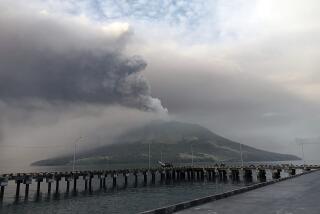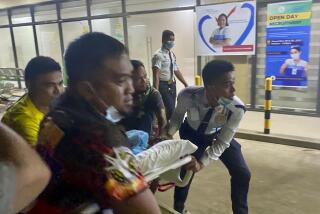Volcano Forces 15,000 to Flee Clark Air Base : Philippines: Americans are evacuated to Subic Bay Naval Base as eruption throws out ashes and debris.
- Share via
MANILA — About 15,000 American service personnel, dependents and civilians were ordered early today to evacuate Clark Air Base, one of the largest U.S. bases overseas, after a Philippines volcano dormant for six centuries began exploding with searing gases, thick ash and deadly debris.
Lt. Col. Ron Rand, a spokesman at Clark, announced at 5 a.m. that all non-essential personnel should begin evacuating the sprawling base as dawn skies over central Luzon island were filled with gray ash and steam from eruptions of Mt. Pinatubo, about 10 miles west.
Rand said Americans who live at or near the base would drive or be bused to the U.S-operated Subic Bay Naval Base, about an hour’s drive to the southwest. The evacuation was to take four hours, he said.
Philippine officials earlier had ordered the evacuation of more than 11,000 people from about 20 villages near the volcano, about 60 miles northwest of Manila, after a series of small eruptions began Friday. No injuries were reported during the weekend.
Raymundo Punongbayan, director of the Philippine Institute of Volcanology and Seismology, said, however, that two moderate eruptions shortly before 3 p.m. Sunday appeared to signal a larger explosion.
“We’re expecting a major eruption,” he said in a telephone interview early today. “ . . . We’re just at the beginning stage of eruptions. We’re expecting many, many more.”
Punongbayan said the 4,795-foot-high volcano was spewing gases up to 1,800 degrees Fahrenheit, thick black ash, boulders and rock fragments in two fast-moving streams from two vents on the western side of the lower summit.
“It’s very dangerous,” he said. “Anything along its path will be destroyed.”
Sunday’s eruptions sent a dense cloud of steam and ash billowing thousands of feet above rice paddies lush green from an impending harvest. Heavy black clouds shrouded the mountain, and a blanket of gray ash covered nearby fields. Debris reportedly was sprayed as far as the South China Sea, 20 miles to the west.
Villagers from a 12-mile radius of the mountain fled the area on foot and water buffalo and aboard crowded trucks and jitneys. The Philippines Red Cross said 11,024 people, including local Aeta aborigines, were evacuated to 18 disaster relief centers set up at schools, but officials said many villagers stayed behind to protect their animals and farms from looters.
“We want to return as soon as possible,” one scantily clad Aeta tribesman told local reporters in an evacuation center in San Marcelino. “We have our farms to attend to.”
The governor of Zambales province, Armor Deloso, said he tried to approach the volcano’s slope Sunday but was forced back by the thick smoke and ash.
“I could not breathe because the ashes were getting into my nose,” he said. “It’s raining ashes.”
Radio reporters near the mountain said the afternoon sky was “like the night.” One reporter said she could see “cracks spewing gray and black steam and smoke” and said trees were “dying with the heat.”
Villagers were advised to avoid valleys and riverbeds in case heavy rains caused mudslides off the mountain.
U.S. and Philippine scientists who flew over the mountain reported a distinct bulging between two steaming vents below the summit, indicating an intrusion of thick magma, or molten rock, from below and a growing instability of the mountain. Punongbayan said the magma dome already was 300 feet long and 90 feet high.
“The dome can continue to grow, and become unstable and then explode,” he said.
He said it was impossible to predict when further eruptions might occur, however. “It’s on an hour-to-hour, and day-to-day basis,” he said. “We have to listen to what the volcano is telling us.”
Rand said the evacuation of Clark was ordered “due to a slight increase of volcanic activity” overnight. All U.S. Air Force planes had moved from the base to Cubi Point Naval Air Station near Subic on Sunday, and infants in the base’s neonatal hospital and other patients had been flown out.
All military personnel at Clark, home of the 13th Air Force, were recalled to the base Sunday afternoon, and U.S. officials ordered local Americans to pack bags and rehearse evacuation procedures.
“People are pretty calm,” said one American woman who lives on the base. “People are prepared.”
As convoys of cars began leaving Clark at 6 a.m., drivers handed the guards file cards with the names and Social Security numbers of those departing. Subic base spokesman Bob Coble said evacuees were being housed in quarters normally used by crews of visiting warships.
The Tarawa, a helicopter carrier visiting Subic Bay after leading a relief mission to cyclone-stricken Bangladesh was put on notice in case its choppers are needed.
Children clutched pets and dolls as a long line of cars and vans packed with household utensils, sleeping bags and luggage left the main gate. Philippine authorities did not evacuate Angeles, the city outside Clark, and scores of residents trooped to the gate to watch the mass departure of Americans.
Ironically, many Filipinos have long demanded that Americans leave Clark, the first U.S. military base established overseas. Washington and Manila have been negotiating over the future of Clark and Subic for more than a year. The current lease expires in September.
Rand said a minimal number of troops will remain at Clark to guard the facility and maintain essential services. Marines from Subic as well as Philippine and American military police were deployed along the road to provide security.
The volcano began showing signs of activity in April for the first time in 600 years, and last week it began belching small amounts of steam and smoke. Seismologists reported a marked increase in volcanic tremors last week, with intense seismic quakes on the mountain last Friday.
Mt. Pinatubo last erupted in 1380, 141 years before Ferdinand Magellan, a Portuguese explorer flying the flag of Spain, first reached the islands in search of spices. Local legend says the mountain was left jagged after a giant prince ripped off the top to give a present to his bride.
More to Read
Sign up for Essential California
The most important California stories and recommendations in your inbox every morning.
You may occasionally receive promotional content from the Los Angeles Times.














